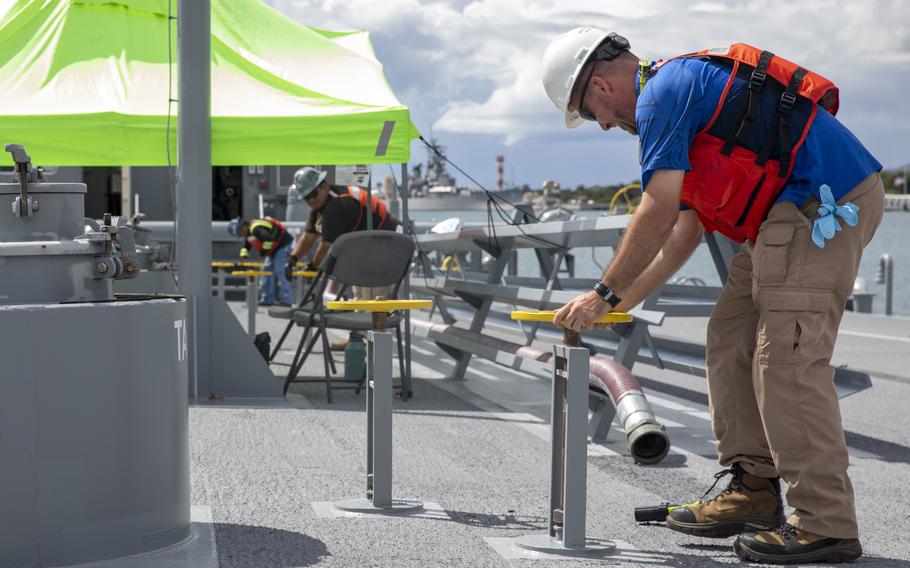
Joshua Kaufman, Naval Supply Systems Command (NAVSUP) Fleet Logistics Center (FLC) Pearl Harbor Supervisory Distribution Facilities Specialist, and other specialists open tank valves aboard U.S. Navy Fuel Oil Barge during an unpacking operation at Joint Base Pearl Harbor-Hickam, Hawaii, Oct. 28, 2022. (Matthew Mackintosh/U.S. Army)
HONOLULU (Tribune News Service) — The Honolulu Board of Water Supply’s top official expressed concern Wednesday that the Navy might try to revive its underground Red Hill storage tanks at some point in the future for fuel use, despite the Department of Defense’s assurances to the contrary.
The Navy is planning to conduct extensive repairs to the pipelines in preparation for defueling the facility at an estimated cost of $280 million. After thoroughly cleaning the pipelines and tanks, the Navy said last week that it hopes to keep the tanks in place as part of its plans for closing the facility and potentially find another nonfuel use for them, such as turning Red Hill into a hydroelectric facility.
But the Navy’s “closure in place “ plan, one of several that is being evaluated, is causing unease.
Ernie Lau, manager and chief engineer of the Board of Water Supply, said that the chance of using Red Hill again for fuel storage should be completely eliminated.
“If there is a beneficial non-fuel reuse that goes on for a while (and ) at some point in the future there is a need for fuel storage, then could the Red Hill Bulk Fuel Storage Facility be resurrected from the dead ?” he said during a Wednesday meeting of the Red Hill Fuel Tank Advisory Committee.
“If the tank liners are still there, the pipes that move fuel to and from Pearl Harbor, if everything is still there in place, we are only one degree of freedom from getting back to fuel storage over the aquifer.”
Lau said that he would prefer to see the steel liners removed from the tanks’ concrete encasing, which could reveal places where petroleum has seeped out, and the tanks filled with inert material.
The Navy’s closure in place plan also spurred the state Department of Health, which has regulatory authority over the facility, to stress that Red Hill must not be used again for fuel or any other contaminant.
“We have made clear to DOD that we don’t believe that the tanks could ever be filled with any hazardous substance or contaminants that could have the potential of contaminating our aquifer, “ said Kathleen Ho, DOH’s deputy director for environmental health during the meeting. “In addition, we expressed these concerns to our congressional delegation.”
Navy officials stressed last week that any future plans for the facility would not include fuel or any other potential contaminants, which they reiterated Wednesday.
The marathon hearing, which included representatives from the Navy, U.S. Environmental Protection Agency, DOH, BWS, lawmakers and members of the public, stretched on for more than seven hours. The meetings, which are now held twice a year, began after 27, 000 gallons of fuel spilled from Red Hill in 2014. The second half of the meeting included angry and sometimes emotional testimony from the public who peppered Navy and health regulators with questions about their response to last year’s Red Hill water contamination emergency. Some told stories about ongoing health problems.
Secretary of Defense Lloyd Austin announced in March that Red Hill would be permanently closed after fuel from the facility contaminated the Navy’s Joint Base Pearl Harbor-Hickam drinking water system last year.
The meeting also included updates from the Navy and federal and state regulators about the status of environmental remediation efforts, a recent health survey of residents affected by last year’s drinking water emergency, and plans to better engage with the public.
EPA and DOH said that the large fuel plume in the vicinity of the Red Hill tanks that began in May 2021 and persisted through early this year had become smaller, a positive sign that fuel contamination in the aquifer was not spreading. Meanwhile, the Navy continues to pump millions of gallons of water a day out of its Red Hill shaft in an effort to remediate the aquifer following last year’s fuel spill.
So far, 1 billion gallons of water have been pumped out of the aquifer—enough water to fill about 1, 500 Olympic-size swimming pools. It’s treated and then deposited into Halawa Stream. The Navy began pumping the water in February, but says there has been no detection of fuel in the water since March, either before treating it or after.
DOH said that pumping, at least at that volume, is likely no longer necessary.
DOH for months has pushed the Navy to come up with a plan for reusing the water, instead of wasting it, but the Navy said on Wednesday it’s still working on a plan.
“It’s a total waste,“ said Melanie Lau, a committee member representing the Moanalua Valley Community Association. “We are under a water restriction mandate here. All of us are voluntarily decreasing our usage. Everything is going brown. The parks are going brown.”
The U.S. Centers for Disease Control and Prevention also provided the results of a survey it recently conducted as part of its effort to evaluate the extent of ongoing health impacts following last year’s fuel contamination.
About 90,000 people were on the Navy’s drinking water system, but only 986 people responded to the survey. Among those that responded, 85% said that they are still using an alternative source for drinking water even though DOH lifted its water advisory months ago. About 65% of respondents said that they believed they were experiencing ongoing health problems as a result of last year’s drinking water contamination. Reported symptoms included headaches, anxiety, dry or itchy skin, fatigue and difficultly sleeping.
(c)2022 The Honolulu Star-Advertiser
Visit at www.staradvertiser.com
Distributed by Tribune Content Agency, LLC.